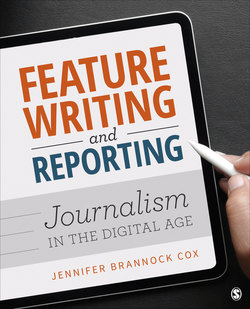Читать книгу Feature Writing and Reporting - Jennifer Brannock Cox - Страница 36
На сайте Литреса книга снята с продажи.
From the Field The Future of Journalism
ОглавлениеInterview with Burt Herman, Director of Innovation Projects, The Lenfest Institute for Journalism
Courtesy of Burt Herman
Being a journalist in the Digital Age has its challenges. Our competition has expanded beyond other media to include everyone with a phone and a social media account. Newsrooms are shrinking as organizations lose ad revenues and subscribers. Trust in the media has decreased as a result of public attacks on our credibility.
Still, Burt Herman is optimistic. As the director of innovation projects at the Lenfest Institute for Journalism, it is his job to seek unique and impactful solutions to help preserve journalism onward through the Digital Age.
“How do we transition from print to online? How do we build digital audiences? What do products for digital audiences look like? What should new start-ups look like? We work with both larger and smaller newsrooms across the country to find out.”
The Lenfest Institute was founded in 2016 by television mogul Gerry Lenfest after he became the sole owner of The (Philadelphia) Inquirer. Lenfest, who died in 2018, donated $20 million to create the Institute, which funds projects geared toward “innovative news initiatives, new technology and new models for sustainable journalism.”17
Although the Lenfest Institute’s mission is big, Herman believes the answers could actually be quite small. Many of the Institute’s projects focus on ways to target community news to the people who need it.
“To me, it just seems like there’s interesting innovation you could do in communities that Facebook or Google can’t do. They’re thinking about large, broad audiences, but if you’re thinking about a niche or a local audience, that’s how you can attract local or paying audiences.
“There are many ways you can get information from around the world on the internet. We need to think about how can we add value.”
Herman wants newsrooms to be at the forefront of technological innovations, creating their own social media platforms and news-friendly devices, starting with tools to personalize information for individual community members.
“What would a local news organization look like if it actually knew your location, if we could tell you there was a health inspection at a restaurant down the street or that real estate prices in your neighborhood are going up? We need to personalize information and make it more actionable for our audiences.”
In changing the industry, Herman says he also wants to change what it means to be a journalist.
“I think there are many new roles to think about that don’t look traditional, and there’s a lot of opportunity there. If you’re an amazing writer and amazing at getting sources, we need people like that. But there are a lot of other roles—excellence in video, audio and thinking about news as a product manager who can lead and develop new things to reach audiences. These are really transferable skills both in journalism and beyond.”
Herman is excited about what the future holds for journalists and their audiences.
“I feel like we have barely begun to embrace the true possibilities of the medium as news organizations. You look at Facebook, Google, Snapchat and see the potential of what you could do, and journalism needs to think of itself as a digital product too. We shouldn’t just use third-party platforms; we need to control our own fate.”
